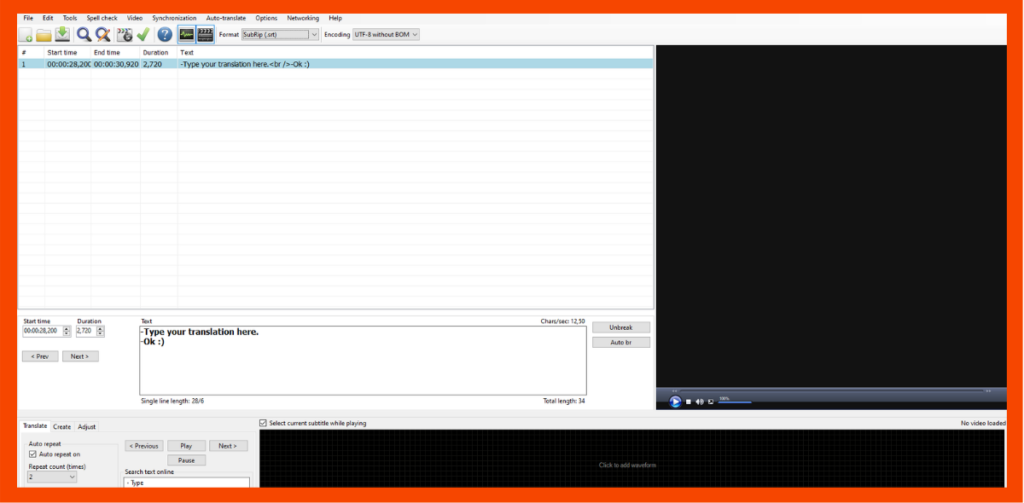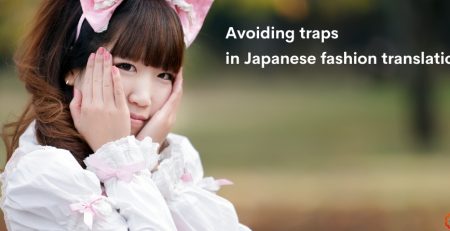Audiovisual translation: all you need to know about subtitling, SDH and more
We’ve been witnessing a tremendous popularity of OTT platforms for a while now. Giant streaming platforms are constantly trying to outdo one another with the number of released films, TV series or original productions. However, to launch anything in a particular location, they all need to provide the target audience with one key service: subtitles or captions in their native language. With the growing number of shows comes a high demand for audiovisual translation. Let’s break it down.
This article is about:
- types of subtitling services,
- the difference between subtitles and closed captions,
- LQA (quality assurance and quality control),
- subtitle translation tools (offline and online),
- Bonus: The fascinating case of oriental subtitling.
Audiovisual translation – types of subtitling services
While working in the audiovisual industry, you may encounter clients with various requirements and resources. Therefore, AVT services may include:
- Creating same language subtitles (SLS) – in simplest terms, SLS involves rendering audiovisual content into word-for-word captioning while keeping the same timing. It usually serves two purposes: creating a template for further translations and trying to aid reading behaviour. It has been scientifically proven in numerous surveys that same language subtitles may enhance reading skills and language acquisition.
- Subtitling in different languages – here, we can differentiate two processes:
- Working on ready-timed templates – some companies provide their own internal tools for captioning, with the source text already adjusted and embedded. It facilitates a linguist’s work as they can focus solely on the translation process and following the client’s style guide.
- Providing all subtitling services from scratch – it includes dealing with proper text formatting, timing and positioning. Such a comprehensive service is more typical while using offline tools which usually require more manual work.
At locatheart, we create professional subtitles for any video content – and in any format. Contact us at info@locatheart.com to check our full range of services.
Subtitling – other services
- Creating timed templates – this task requires some extra effort as linguists have to account not only for dialogues but also for on-screen events and forced narratives (FN = text overlay, burned-in texts such as a sign or a text message). Moreover, they often face the dilemma of deciding which event is more plot-pertinent if, for instance, a dialogue overlaps with an FN. While working on a template, linguists are expected to include extra annotations that provide additional context for translators. These remarks may shed some light on cultural references, slang expressions, idioms, jokes, puns, etc. Usually, specific guidelines and strategies are listed in the specifications received from the client.
- Conformance – aligning captions with a given file format, making sure that timing and audio extracts are adjusted to the final version, that subtitles are not out of sync and that the delivered content is compliant with specific contexts / cultures / regions / product placements. It also means taking care of style guide conformance and the overall consistency.
Subtitles vs. closed captions – what’s the difference?
Although it may seem that both terms – “subtitles” and “closed captions” – can be used interchangeably, the things they denote are intended for different audiences.
Subtitles are targeted at hearing viewers who do not know the source language. Therefore, they involve mainly dialogues and FNs.
Closed captions (SDH subtitles), on the other hand, are prepared for those audience members who are deaf or hard of hearing. They account for such aspects as audio sound effects, music, noises or speaker identification.
![SDH subtitles - LocAtHeart translation agency [screenshow from a movie with an example of SDH subtitles]](https://locatheart.com/wp-content/uploads/2021/08/audio-visual-translation-SDH-subtitles.png)
Example of SDH subtitles
Quality assurance (QA) and quality control (QC)
It is common practice in the localisation industry to outsource such tasks as conducting LQA, i.e. quality assurance or/and quality control of embedded subtitles. At locatheart, we strive for the top-notch quality, thus we believe that both QA and QC check-ups should be covered. It includes both linguistic revision (proofreading, spotting and correcting grammar or subject-matter errors) and technical review (checking synchronisation between text and audio, ensuring that all the specifications described in the style guide and in the client’s brief are adhered to).
Tech check
High quality is important both for the commissioning and the commissioned party. To ensure the desired level of service, it is necessary to implement certain control mechanisms. The process that all our subtitles must undergo is called ‘tech check’. Thanks to it, we can closely monitor a project and confirm that the subtitles follow the guidelines for a particular language and that their quality meets the requirements set by the client.
We begin our work by comparing the number of lines in the target file with the number of lines in the source file. We check if the right format has been set for the subs. Then, we move on to the ‘proper’ tech check, a phase during which we analyse all the lines in terms of most common errors. We pay attention to even the smallest details which may include double punctuation signs, three dots instead of the ellipsis sign, appropriate quotations marks for a given language, etc. We make sure that capital letters are used where they should be, as well as italics. We also double-check if the text is positioned correctly on the screen (tags). Furthermore, we ensure that no subtitle line exceeds the specified character limit, which later on translates into viewers’ reading comfort. Afterwards, if necessary, we make minor adjustments to synchronise the subs with the image (frame rate is very important here).
During the whole procedure, we keep in touch with the translator to dispel any linguistic doubts. It’s important for us that the subs are reviewed by two specialists, as it increases the probability of eliminating every single mistake.
Technical verification is a way of identifying and stamping out any potential flaws within the subtitles. It’s a preventive process with the purpose of delivering files of the highest possible quality for the users, as well as making sure that those files meet the required standards. Tech check is carried out for every project, regardless of the language or the number of lines in the subtitles. At locatheart, we take care of even the tiniest of details – all for the satisfaction of our clients.
Paulina Świetlak
Audiovisual translation: how do we produce the desired results?
First of all, we believe in the power of 3 stages while working on any end-to-end linguistic assignment, and these are: translation, editing and proofreading. Only then can you minimise the risk of committing an error. That’s why we always devote some time to double-checking the work before we press the “Submit” button. What’s more, we’re flexible and can adjust the scope of our work for each client individually. Whether it’s solely a QC, a QA check-up or “the whole package”.
If we are faced with a more complex project, let’s say, a 40-episode TV series, we always create and develop a KNP (Key Names and Phrases) – a spreadsheet that contains a glossary, a list of all occurring characters, a chart presenting relationships between the said characters (formality), exports of all completed episodes, as well as helpful links or resources. It allows us to maintain consistency even if a larger team works on the project.
Tools for audiovisual translation
Subtitling: online tools
Vendors take different approaches while outsourcing AVT projects. It frequently depends on their budget and business models. The biggest players in the market often provide their own internal online tools for subtitling. Moreover, every target language comes with a different style guide and a separate set of linguistic rules to follow. Each subtitling platform varies in terms of UX/UI design, shortcut keys or general layout. The core mechanism, however, is relatively similar. Therefore, at locatheart, our specialists work in an agile manner and can easily adapt to any online subtitle editor.
Internal tools for subtitling/captioning are usually advanced and well-devised, so the linguistic team gets to work on ready-timed templates with updated glossaries, tips on how to approach a vague phrase in the source language and convenient pop-ups warning against exceeding reading speed or character limits. What’s more, it allows linguists to avoid issues with file formatting and maintaining consistency across all files.
Subtitling: offline tools
When it comes to external offline tools, the subtitling process may get more complex and time-consuming on both sides involved. It concerns both technical and translation stages: uploading a video, creating a template, adjusting time duration for each event, completing translation work and preparing a correct target file (bearing in mind the required file format).

Preview of an external offline translation tool: Subtitle Edit 3.6.0, required file format: .srt
Audiovisual translation (AVT): other crucial aspects you need to consider
It cannot be stressed enough that a style guide plays a key role in determining our translation strategies. It touches the following matters:
- character limitation per line;
- minimum and maximum duration of one subtitle event;
- dealing with cultural references, puns, word plays, slang expressions;
- localising song lyrics;
- italicisation: foreign phrases, lyrics, off-screen speakers;
- translating FNs;
- capitalisation (for instance – FN capitalisation);
- accepted reading speed;
- positioning strategies – placing subtitles at the bottom or raising them to the top to avoid overlapping;
- file format (for instance: .dfxp, .xml, .ttml);
- line treatment;
- dialogue marking (for instance – whether there should be a space between a hyphen and the initial letter);
- punctuation;
- writing numbers (whether numerals should be spelled out or written numerically);
- translator’s credit.
If your organisation lacks technical documentation regarding subtitling projects, our Project Managers can assist you in preparing a list of necessary requirements.
The fascinating case of oriental subtitling
When it comes to guidelines, matters get even more complicated (but all the more exciting!) in the case of Japanese, Chinese and Korean. These languages are complex. There are idiosyncrasies related to their respective writing systems, as well as different historically and culturally grounded linguistic conventions. Translators need to face a myriad of challenges that are virtually unknown to their counterparts working primarily with European tongues. Take Chinese captions. What might be particularly striking at first glance is the general absence of periods and commas. Korean subtitles, on the other hand, might surprise a first-time viewer with the lack of italics. Emphasis is marked by single quotation marks. Another surprise: the inclusion of onomatopoeic words. They are usually avoided when dealing with dialogues in Western languages.
It seems, however, that the language that demands the most back-breaking work when it comes to meeting technical requirements is Japanese. The examples of exacting tasks are copious indeed. Not only does the template make use of vertical subtitles (in addition to the standard horizontal ones), but they are also governed by a separate set of elaborate rules. Things get even more labyrinthine. Translators have to use the so-called rubi (ルビ) and bouten (傍点) whenever applicable – given the complexity of the Japanese writing system, some characters must be annotated with tiny glosses (rubi) to ensure that viewers (especially children) can read the text correctly. And because of the characters’ inherent intricacy – and the distortive quality of italics – bouten (typically dots placed above, below or next to characters) are used to emphasise particular words or phrases.
As can be seen, when it comes to Eastern languages, it is extremely easy to get lost in the intricate maze of rules, exceptions and specifications – that’s why it would be best to leave the creation of subtitles to professionals equipped with “navigation devices” essential for making the right technical choices.

![Audiovisual translation How subtitles are made - LocAtHeart translation agency [header]](https://locatheart.com/wp-content/uploads/2021/08/Audiovisual-translation-How-subtitles-are-made-LocAtHeart-translation-agency.png)




Comment (1)
Hello!
I’m interested in learning more about sound effects for SDH closed captions, especially those related to backgrounds, fights, and swords. I’m deaf, so I can’t hear everything, and I’m wondering if you can provide a list of sound effects names. I’m particularly interested in films with SDH, including background sounds, fight scenes, and sword-related sounds. Thank you!